When I first saw these beautiful brown figs at the farmer’s market, I knew I wanted to use them in a dessert. Because they were so fresh and juicy, I didn’t want to bake them into a cake and lose their delicate flavor. Instead, I thought they’d be perfect as a topping on a creamy tart.
On the blog, there are a small number of recipes that I find myself making again and again (usually when I’m pressed for time or faced with an impromptu potluck or celebration that needs something great right now). These are the workhorses, the ones that come together pretty fast and almost effortlessly.These supernatural brownies, for instance, have never let me down. And of course, this lemon cream tart.
I first made this lemon cream tart a few years ago and have probably made it at least a few times a year since then. Even with my ever-growing list of new recipes to try, I can’t resist but come back to this one — it’s that good. The recipe comes from several different sources that I’ve meshed together throughout the years.
The lemon cream recipe comes from San Francisco’s Tartine Bakery and their namesake cookbook. Tartine is a few blocks away from my apartment and is known for their giant croissants, hearty bread, and of course, long lines. Truth be told, I’ve always thought Tartine was a little overrated (UNPOPULAR OPINION, I know! San Franciscans — I can hear your shocked gasp now; sorry/notsorry), with the exception of their lemon cream tart. For that tart and that tart alone, I would brave the bakery’s ridiculous lines.
What makes their lemon tart so special? It’s that damn lemon curd. It’s not so much a lemon curd as it is a lemon pudding, or even lemon cream. Lemon curd is traditionally made by whisking lemon juice, eggs, sugar, and butter together over a double boiler until it thickens. It’s delicious, and a classic. However, Tartine deviates from the traditional method by first making a lemon curd with just lemon juice, sugar, and eggs, and then adding butter after the other ingredients have been combined. By blending in a generous amount of butter (and lord, is there BUTTER!) into the initial lemon curd, you’re left with a cream that’s smoother, lighter, creamier, and less tart than traditional curd. To wit — most lemon curd desserts need meringue or whipped cream to balance out the curd’s tartness. Tartine’s lemon cream does not. It’s remarkable, and I’ve never had anything like it.
All this lemon cream goodness sits atop of one of the best brown butter pastry tart shells that I’ve ever made. This recipe comes from Paule Caillat, the founder of the Promenades Gourmandes Cooking School in Paris. Similar to the lemon cream recipe, I found this recipe on Food52 several years ago (although it has now been forever immortalized in their Genius Recipes cookbook) and it hasn’t let me down yet. The tart shell has a wonderful flavor that reminds me of Scottish shortbread, and a texture so hearty that it maintains its crumbly, crispy nature against liquids like the lemon cream. And what’s more, it’s incredibly, incredibly, INCREDIBLY easy to make. No joke.
I usually think of pastry dough as something fussy and a royal pain in the butt to make, but this recipe proves me wrong. There’s no chilling of the dough, or even rolling out the dough — all you need are your hands and a heatproof rubber spatula. No fancy equipment is needed, either — just a heatproof bowl and your tart shell, and you’re good to go. I promise.
So what are you waiting for?! Just make this tart! I hope you like it as much as I do, because I’m sure you’ll see this lemon cream tart make an appearance on the blog again and again in the next few years.
Some baker’s notes:
-
- This crust is easy to put together, but sometimes it does have a tendency to crack here and there. Use a European style butter that has more fat than American butter (e.g. Plugra butter, and Whole Foods often has other brands including a generic version) to minimize cracking. If you don’t want to bother sourcing European butter (which I often don’t, because I’m cheap and lazy), simply reserve a pinch’s worth of raw dough to spackle into any cracks when the tart is fresh out the oven and cooling on a wire rack. There’s no need to bake again — the residual heat from the tart will bake the dough.
-
- When working with any citrus juice (or really, most acidic liquids), be sure to use a non-reactive glass or ceramic bowl or pot! Using a stainless steel or even copper will cause a reaction that will leave your curd tasting metallic. Since the lemon sits in the bowl for a long time, it makes a big difference in flavor when using a glass bowl.
- This recipe works best with a quick-read thermometer (FYI — I really, genuinely love my quick read candy thermometer), but you can wing it without one. Just keep whisk the lemon juice, eggs, and sugar for around 10 to 12 minutes, until the mixture thickens enough for a whisk to leave a trail behind.
Get the Recipe: Fresh Fig and Lemon Cream Tart
Ingredients
For the Brown Butter Tart Shell
- 6 tablespoons (3 ounces) unsalted butter
- 3 tablespoons water
- 1 tablespoon grapeseed oil
- 1 tablespoon granulated sugar
- a pinch of kosher salt
- 6 ounces all-purpose flour
For the Lemon Cream Filling and Fig Topping
(makes enough for one 8-inch tart)
- 1/2 cup plus 2 tablespoons (5 fl. ounces) freshly squeezed lemon juice
- 3 large eggs, at room temperature
- 1 large egg yolk, at room temperature
- 3/4 cup (5.25 ounces) granulated sugar
- a pinch of kosher salt
- 1 cup (2 sticks // 8 ounces) cold unsalted butter, cut into 1-inch cubes
- 1 pint ripe figs
Equipment
- a medium oven safe bowl (I used a Pyrex bowl from this set)
- an 8-inch tart pan with a removable bottom
- a quick-read digital thermometer
- an immersion blender (or a regular blender works too!)
Instructions
For the Brown Butter Tart Shell
- Preheat the oven to 410 (F).
- In a medium oven safe bowl, combine 6 tablespoons unsalted butter, 3 tablespoons water, 1 tablespoon vegetable oil, 1 tablespoon sugar, and a pinch of salt.
- And now, this is going to sound really weird, but place the bowl in the preheated oven for 15 minutes, until the mixture is boiling and the butter starts browning.
- After 15 minutes, remove from the oven (but keep the oven on!), and add 6 ounces of all-purpose flour by quickly spooning in flour in 1 tablespoon sized chunks. Use a heatproof rubber spatula to stir in the flour. As you do this, the mixture is also going to bubble and smoke, but trust the recipe! It works, I promise. The end result is a dough that pulls off the sides of the bowl and looks a little bit like a lump of mashed potatoes.
- Once the dough is cool enough to touch, transfer the ball of dough into an 8-inch tart pan. Use the back of your hand to flatten out the dough onto the bottom of the pan, and your fingertips to mold the dough up into the corners and sides of the pan. It’s going to feel really greasy and kinda unpleasant, but go with it. Once the tart dough has covered the pan completely, use a fork to poke several holes into the crust.
- Bake at 410 (F) or until the crust is light brown and starts to appear flakey around 15 minutes. Remove carefully from oven and let rest on a wire rack.
For the Lemon Cream Filling
- Pour 2 inches of water into deep, heavy-bottomed saucepan. Place over medium heat, and bring the water to a simmer.
- Combine 1/2 cup plus 2 tablespoons lemon juice, 3 large eggs plus 1 egg yolk, 3/4 cup sugar, and a pinch of salt in a glass bowl. Place the glass bowl over the saucepan containing the simmering water to create a double boiler, ensuring that the bottom of the bowl does not touch the water. Whisk until the mixture becomes very thick and registers 180 (F) on a quick-read digital thermometer. As you're whisking, be sure to never let the egg yolks and sugar sit together for more than a moment without stirring – the sugar will cook the yolks and turn them granular! Don't let that happen, or your tart will be weirdly textured and I will cry for you.
- After the mixture reaches 180 (F) (after around 10 to 12 minutes), remove the bowl from over the water and let cool on a wire rack to 140 (F), stirring gently from time to time to release the heat.
- Once the mixture reaches 140 (F), use an immersion blender to blend 1 cup unsalted butter a few cubes at a time into the lemon curd. Blend well after each addition of butter and make sure the cubes are fully incorporated before adding the next few pieces. As you add more butter, the cream will start to turn into a pale yellow with take on a thick, opaque texture.
- Once the butter has been fully incorporated, cover the surface of the lemon cream with a layer of plastic wrap and transfer to the refrigerator to chill for 1 to 2 hours before serving.
Assembly
- Once the lemon cream has chilled for a few hours and you're ready to serve the tart, use a rubber spatula to carefully pour the lemon cream mixture into the prepped shell, smoothing out the cream with an offset spatula so that it spreads around the tart pan evenly. Decorate with sliced figs and serve immediately.



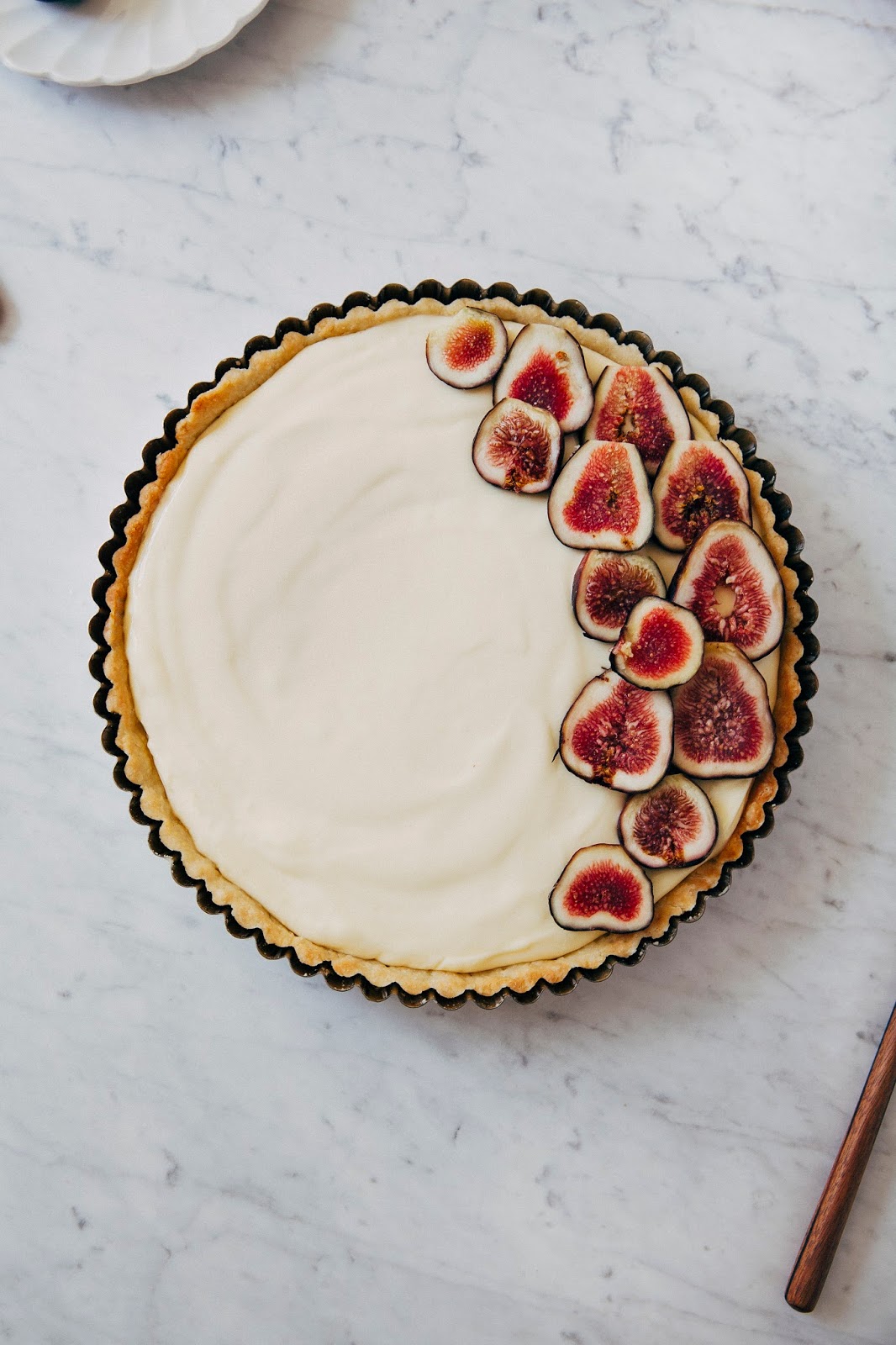
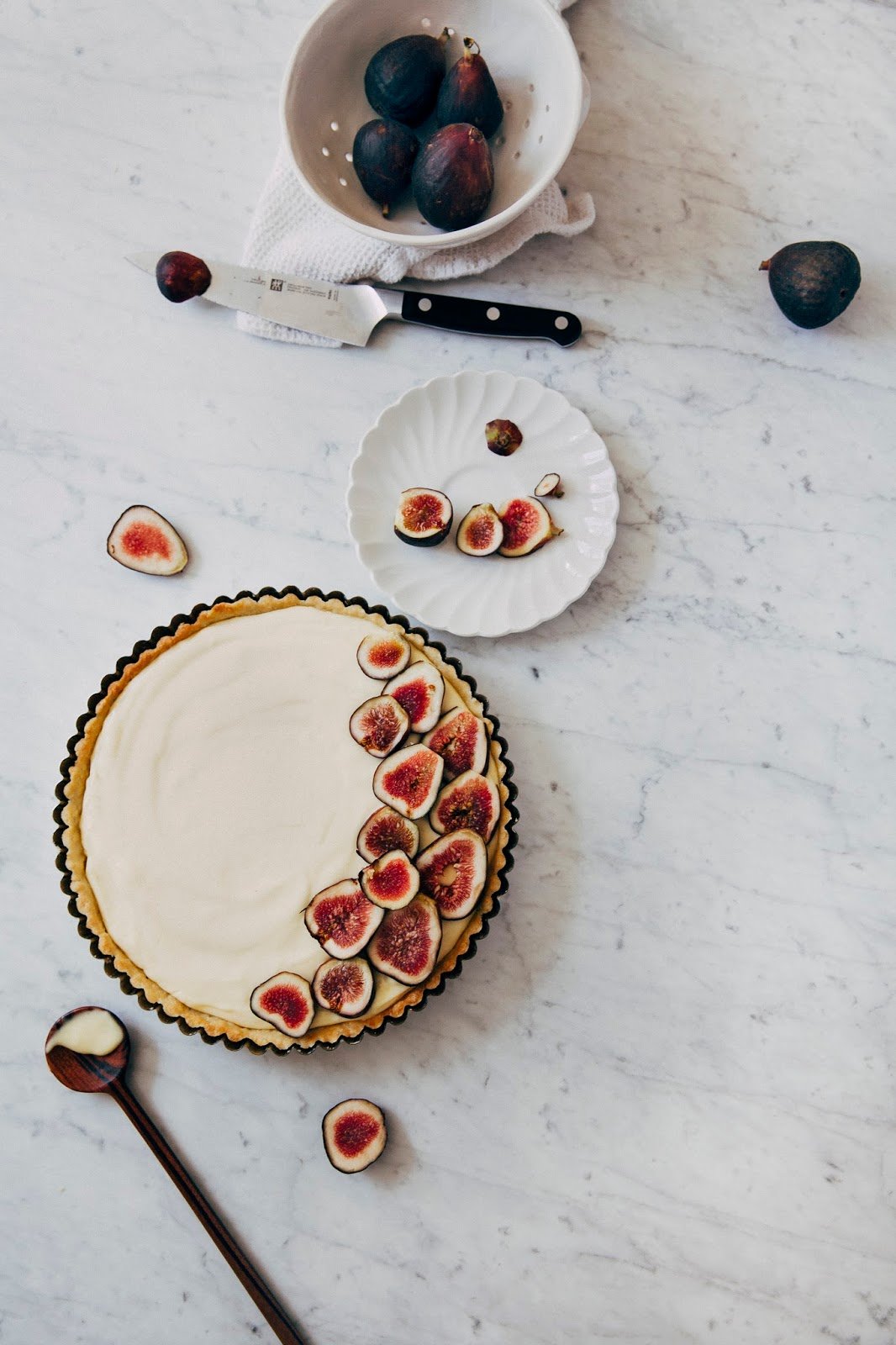

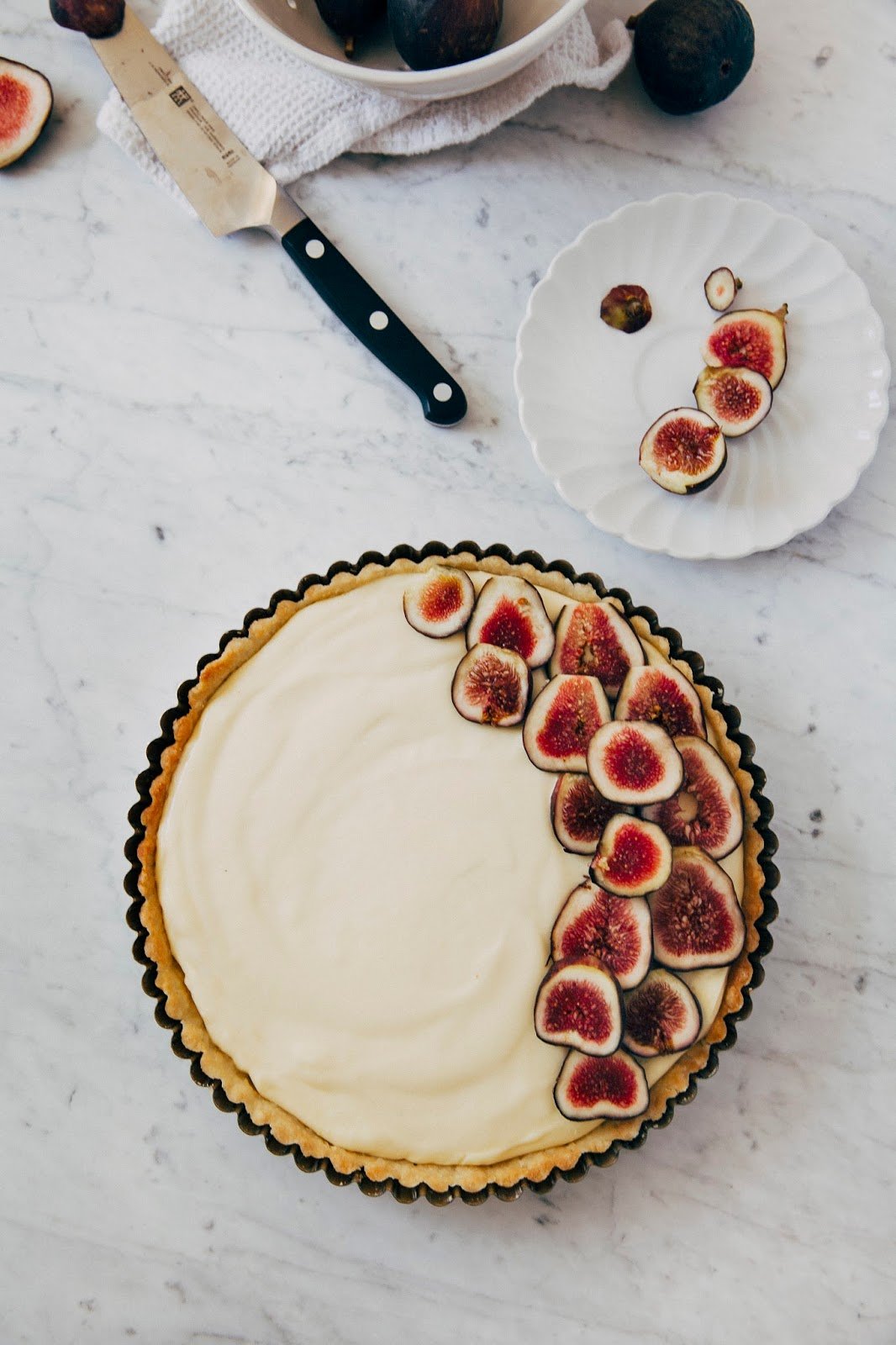
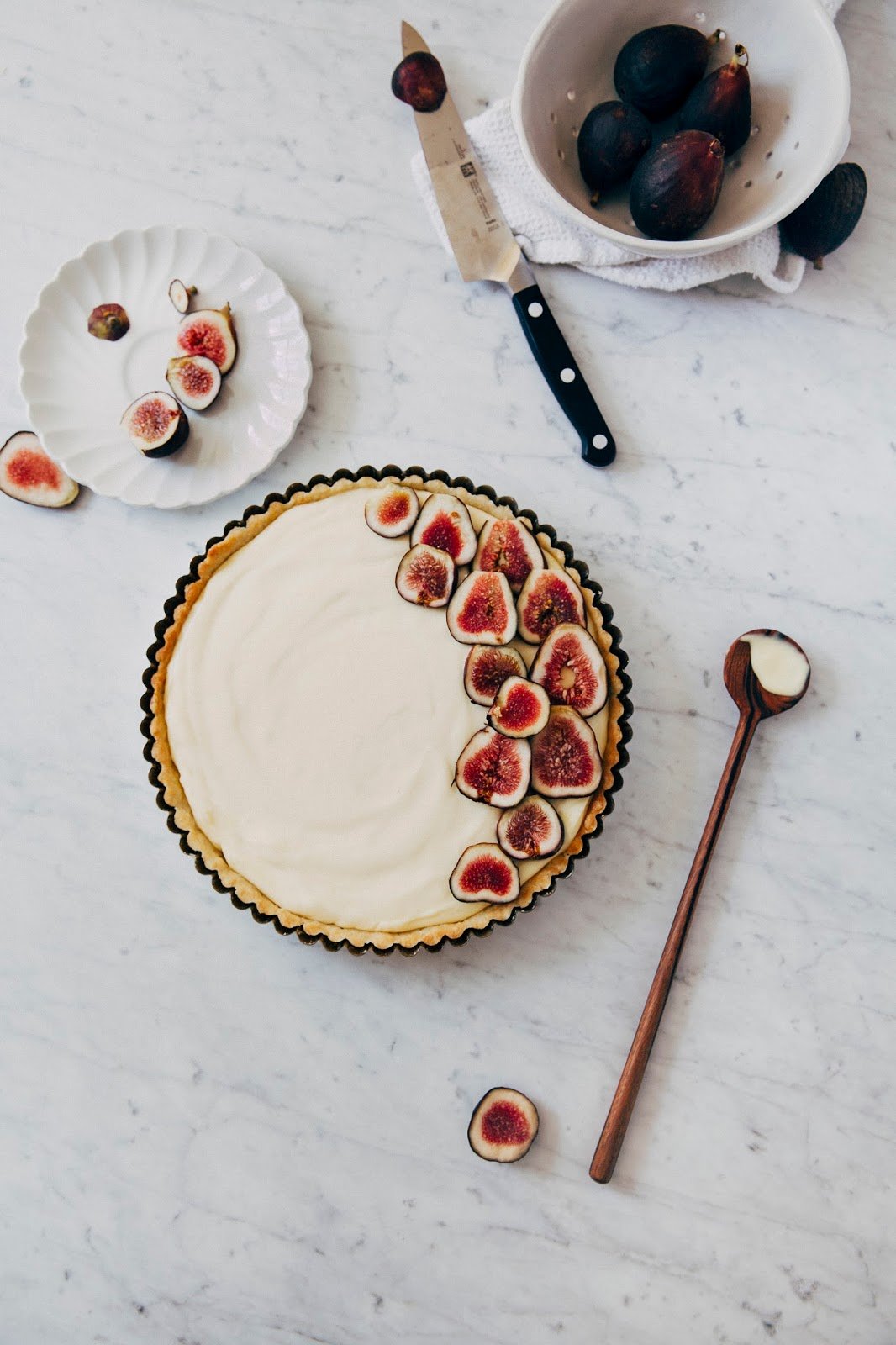
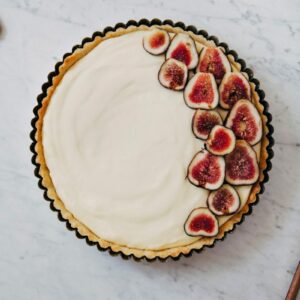

Looks gorgeous and delicious! I’m wondering, can I substitute canola oil or olive oil for the grapeseed oil?
Yes, either of those oils work!
Thank you!